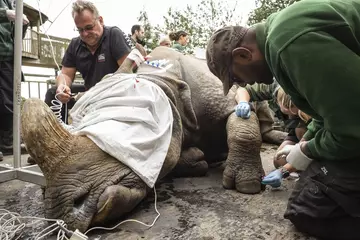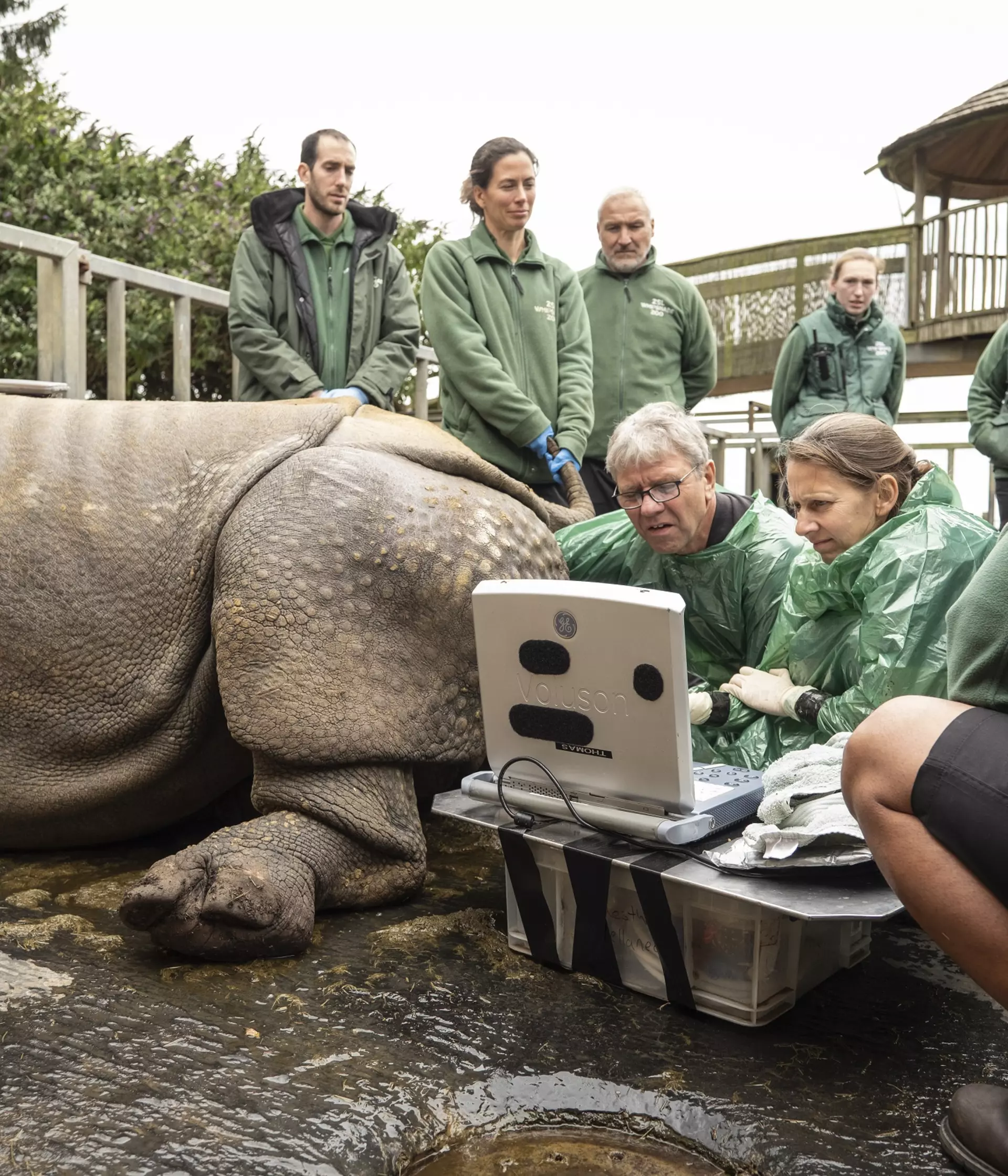
We're celebrating an extraordinary result for a female greater one-horned rhinoceros, which revealed medical treatment has significantly reduced the presence of tumours in her reproductive tract.
Rhino vet care
Our two female greater one-horned rhinos (Rhinoceros unicornis), 29-year-olds Behan and Beluki, have been under the care of vets, after both were found to have tumours and cysts in their reproductive organs, which was impacting their health and welfare.
As part of their tireless efforts to treat the condition – which is sadly common for older female rhinos in both zoos and the wild – our vets called upon reproductive specialists at the Leibniz Institute for Zoo and Wildlife Research (IWZ) in Germany. A treatment plan was devised for the rhinos with both receiving an immune-contraceptive vaccine twice a year, designed to stop hormones from stimulating the tumours, and ultimately shrinking them.
This week, both rhinos were given a general anaesthetic so that our veterinary team and rhino keepers could see how the treatment was working and assess the rhinos’ health. IWZ’s Thomas B. Hildebrandt, Frank Goritz and Susane Holtze flew in from Berlin to assist with examining the rhinos, and they were also joined by a leading specialist equine surgeon from Rossdales Veterinary Surgeons.
Vet care at the Zoo
During the ultrasound scan, our vets were surprised – and delighted – to see that Behan’s previously large tumours had responded so well to treatment that they could barely be seen at all.
Senior vet Dr Taina Strike said: “We went into the procedure prepared for multiple outcomes, but I don’t think any of us was expecting to see such an incredible result for Behan. The tumours are almost invisible on the scan, and the ovarian cysts have completely disappeared. We will continue to closely monitor Behan as she gets older – but for now, the ongoing treatment is working and we’re delighted that we’ve been able to put her condition into remission.”

While Behan has made remarkable progress, the team were deeply saddened to discover that Beluki, whose condition was more advanced when diagnosed, had not responded to the treatment in the way they had hoped. Following a thorough examination, the veterinary team determined that her condition had progressed too far, and her tumours were inoperable. The decision was made to prevent Beluki from any future suffering, and she was not brought round from the general anaesthetic.
“Today has been an incredibly bittersweet day for Whipsnade Zoo,” said Taina Strike, our Senior Veterinary Officer. “While Behan’s remarkable recovery has given us all hope, we, and her dedicated keepers, are heartbroken by the loss of Beluki, who has lived with us since 1998.
“During the ultrasound examinations this week we found a marked difference in the conditions of both rhinos. Beluki’s tumours were inoperable and impacting other organs, meaning her quality of life was only going to deteriorate - the kindest decision we could make was to euthanise her.”
“We’ll be working together with the experts from Leibniz Institute for Zoo and Wildlife Research and our ZSL pathology team to try to understand the difference in tumour response to treatment in our two rhinos, which could have an impact on other such cases globally.”
Information gained from both rhinos will be added to a global database shared by vets, animal carers and conservationists across the globe – and will be used to inform conservation efforts for the species which is considered to be vulnerable to extinction. Every animal that dies at the Zoo undergoes a post-mortem examination, which provides critical insight into endangered species.
Taina added: “This marks a notable stride forward in treating the reproductive pathology that is so common in these gentle giants.”
“Just like with humans, early diagnosis often leads to better outcomes, so we’re now investigating if earlier reproductive health checks for greater one-horned rhino should be recommended. As Behan ages, she will continue to help us understand the effectiveness of medications aimed at treating these conditions, and this vital information could ensure other rhinos will survive as she has.”

Greater one-horned rhino conservation
As well as habitat loss driven by increasing human populations, greater one-horned rhinos have been decimated in the wild by illegal hunting – driven by false beliefs of the medicinal power of their horns. Through ZSL we've been working in Chitwan National Park for more than 25 years, working with the Nepali government, local communities and conservation partners to establish anti-poaching patrols, which are successfully keeping poaching under control.
In 2021, ZSL recorded the largest numbers of greater one-horned rhino in Nepal since the 1960s. ZSL is supporting the slow but steady recovery of their population – greater one-horned rhino have a 16-month gestation period and usually give birth to a single calf approximately every three years – and its efforts have helped to achieve a 17% increase to their numbers over the last few years.
